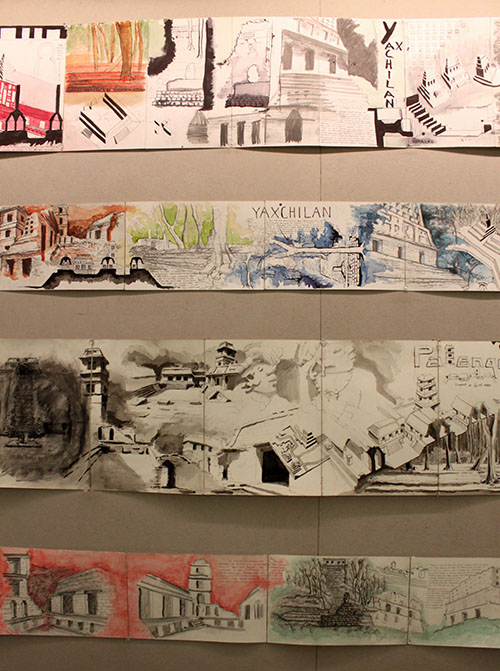
FAYETTEVILLE, Ark. — Six University of Arkansas architecture students traveled to Mexico City this past summer with their professor, Russell Rudzinski, to not only broaden their architecture knowledge but to widen their horizons about life outside of their comfort zone. Now, their findings have manifested into sketches on display along the main corridor of Vol Walker Hall.
Over the past 15 years, Rudzinski has taken many students to Mexico City to fulfill their study abroad requirement within the architecture program in the Fay Jones School of Architecture and Design.
"It is a travel abroad program that studies Mexican urban space and architecture," said Rudzinski, who directs the Mexico program. "It is a way of broadening the students' cultural experiences."
Rudzinski, who is also a clinical assistant professor in the school, said that the Mexico program offers many benefits. In a typical semester, architecture students often spend many hours in studio, and they put a lot of time and effort into their work. This program allows students to get out of the classroom and into the world. It gives them chances to see and understand architecture, buildings and color through a different cultural perspective.
With Mexico's rich history, students were able to learn about how the architecture has survived and changed throughout time. They were also able to see buildings in a completely different habitat than what they were used to.
The experience "turns sometimes very skeptical or fearful students into ambassadors of Mexico City," Rudzinski said. "There are a lot of preconceptions about Mexico that are ill-informed, so they encounter things that they did not expect."
The students did not just travel for exploration purposes, but for specific learning objectives as well. The work consisted of a two-pronged approach with research through travel and research through design.
Students would travel and record their observations through words and pictures in order to analyze what they were seeing. Some of that student work — page after page of paper, taped together in accordion style — is what's on display in the corridor display case.
Then, students would reflect on what they observed and manifest that into design proposals in the studio. This year, the group proposed an expansion of the Universidad del Claustro de Sor Juana - a young and growing university in Mexico City that embraces cultural and culinary traditions. Situated along the southern boundary of the Centro Historico, the university expansion proposals considered the role of the institution in the city, the question of increasing urban density and the studied relationship between historic and contemporary architecture.
The first three weeks of their summer studio were spent traveling and exploring. The day-to-day life of the students was much like a typical workday, in which studio began at 9 a.m. They broke for lunch at the market or local taquerias, and then worked until 6 p.m. Then, students were free to go back to their host families in the evenings and enjoy Mexican nightlife.
One of Rudzinski's favorite moments from the trip was when their car got stuck in traffic while driving through a mountain road because of a protest. It was during an election, and a small village decided to block the highway. They decided to make the best of it and took out some of their tools and made playing cards, then played games while they were waiting for the traffic to clear.
Mexico City is a great place to study architecture and learn abroad because it is a city of about 24 million people, and for many students that is the biggest city they have been in, Rudzinski said. The cultural potency of Mexico City is strong too; it is rich with arts, politics, economics, innovation and more.
"The city shows students that there are opportunities everywhere to change the world," Rudzinski said.
Rudzinski said that he loves being a part of the program and choosing to join it was the best professional decision he has ever made. He said that he hopes to continue to be an integral part of it for a long time, and that it continues even after he is gone.
Contacts
Leigha Van Sickle, communications intern
Fay Jones School of Architecture and Design
479-575-4704, ljvansic@uark.edu
Michelle Parks, director of communications
Fay Jones School of Architecture and Design
479-575-4704, mparks17@uark.edu